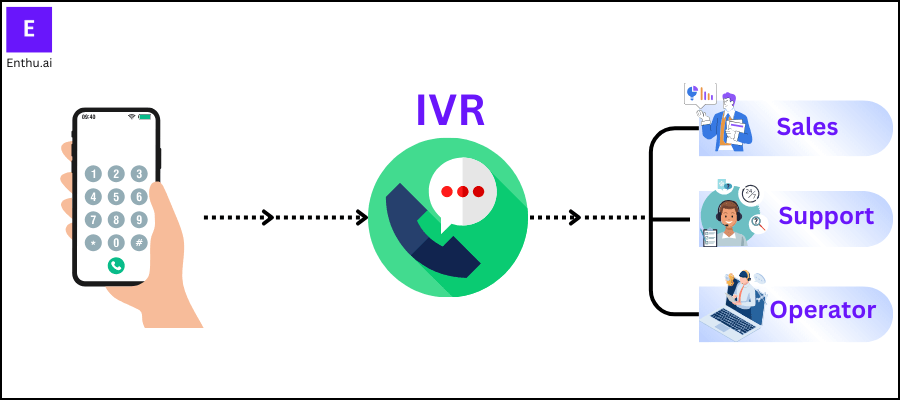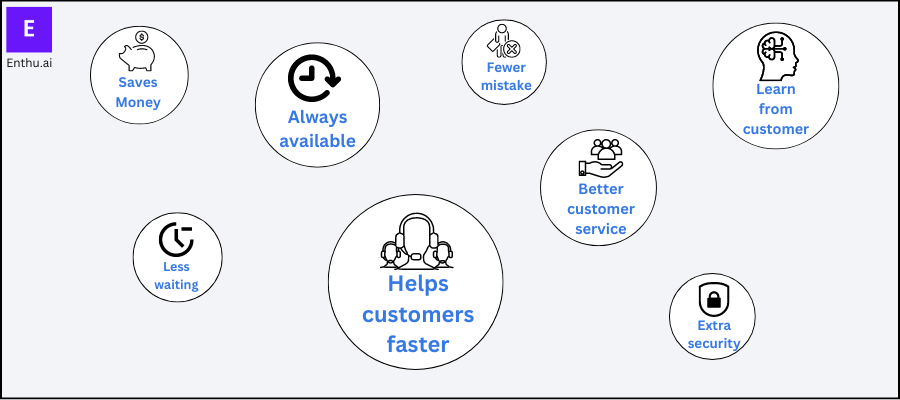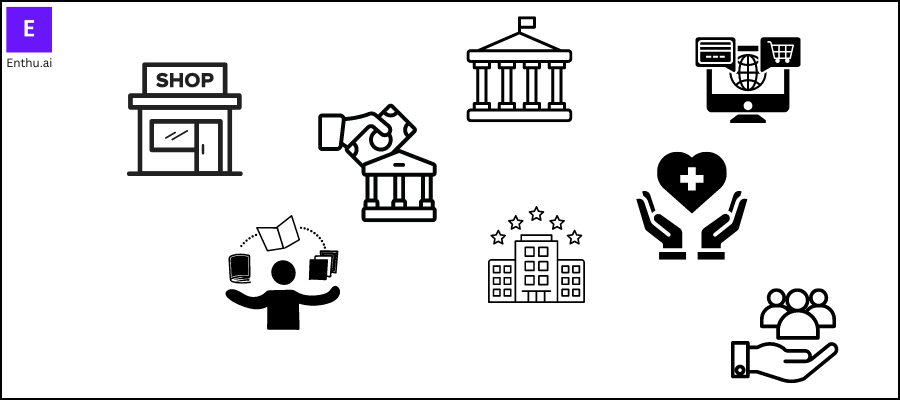When calls are put on hold or transferred longer, it can result in frustrating customer experiences.
They feel like their time is being wasted, they’re not valued, and the service quality is poor.
According to HubSpot research, “90% of customers rate an “immediate” response as important or very important when they have a customer service question. 60% of customers define “immediate” as 10 minutes or less.”
Therefore, it’s vital to have an advanced system at your disposal to help your agents respond faster, decrease the average resolution time, and keep the backlog to a minimum whenever a customer calls your support team.
IVR, Interactive Voice Response is a cutting-edge technology that can help you achieve these goals.
In this article, we delve into IVR, how it works, its benefits, challenges, use cases, and its impact on customer service and call center operations.
A. What is interactive voice response IVR?

Interactive Voice Response (IVR) is an automated phone system technology.
When a caller calls a company and hears a menu of options like “Press 1 for sales, press 2 for support,” that’s IVR.
It’s a system that answers calls automatically and gives callers choices using their keypad or voice.
IVR interacts voice with customers using pre-recording messaging or text-to-speech technology with a dual-tone multi-frequency (DTMF) interface.
IVR helps businesses manage their calls more efficiently. It can handle common questions without needing a human to pick up the phone.
So, if a caller wants to check their account balance or track a package, IVR can help them without waiting to talk to someone.
There are different types of IVR systems. Some use buttons on the phone, while others understand what a customer says. The advanced ones even recognize a caller’s voice.
IVR is great for both customers and call centers. Customers get quick answers to their questions, and call centers to save time and money by not needing as many people to answer calls.
Moreover, IVR can direct a call to the right agent faster, so the caller doesn’t waste time being transferred around. Overall, it makes phone calls smoother and less stressful for everyone involved.
B. How does interactive voice response work?
Here’s how it typically works:
- The customer calls the customer support number.
- The IVR system welcomes the caller and gives them options, like “Press 1 for billing questions, Press 2 for technical support.”
- The caller chooses the option that matches why they’re calling.
- The IVR can do different things based on their choice, like providing information, routing the call to the right person or department, or even letting the caller schedule a callback.
IVR is powered by technology that understands customer responses, whether speaking or using the touch tone keypad.
It’s super handy because it saves customers time waiting to talk to an agent on hold.
Plus, it helps companies manage many calls more efficiently to provide better service to everyone.
IVR has come a long way since its early days.
Today, IVR systems are even more advanced, thanks to technologies like natural language processing, which allows customers to talk to the system more conversationally.
C. The benefits of using IVR

Here’s why businesses love using IVR:
1. Saves money
IVR automation reduces the need to hire additional customer service representatives, thereby cutting labor costs.
Businesses can efficiently manage high call volumes by handling routine tasks without significantly increasing operational expenses.
2. Always available
IVR systems operate round-the-clock, ensuring customers can access basic information or assistance anytime, even outside regular business hours.
This availability enhances customer satisfaction by providing convenience and accessibility.
3. Helps customers faster
IVR guides customers to the appropriate department or information quickly, reducing the time spent navigating through menus or waiting on hold.
This efficiency improves the overall customer experience by resolving issues promptly.
4. Better customer service
IVR systems can prioritize and assist essential customers, such as VIP clients or frequent buyers.
By offering special treatment, businesses can strengthen customer relationships and enhance loyalty.
5. Less waiting
IVR systems minimize wait times by efficiently routing calls and offering callback options, allowing customers to avoid long hold times.
This reduces customer frustration and improves satisfaction by providing a seamless communication experience.
By effectively routing calls and providing callback choices,
6. Fewer mistakes
IVR automation reduces the likelihood of errors compared to manual processing by human agents.
By following predefined scripts and workflows, IVR systems ensure consistency and accuracy in handling customer objection, inquiries and transactions.
7. Learn from customers
IVR systems can collect and analyze data on customer interactions, including commonly asked questions and issues raised.
This valuable insight enables businesses to understand customer needs better, identify trends, and make informed decisions to improve products or services.
8. Extra security
IVR systems with voice recognition technology add a layer of security by verifying callers’ identities before granting access to sensitive information or performing transactions.
This helps protect customer data and mitigate the risk of unauthorized access or fraud.
💡 Pro Tip: Analyse your call center calls using the best speech analytics platform available in the market.
9. Lots of options
IVR systems offer various channels for customers to seek assistance, such as leaving voicemails, requesting callbacks, or accessing self-service options.
This flexibility accommodates diverse customer preferences and enhances the overall customer experience.
10. Improves workflows
By automating routine tasks, IVR systems free human agents to focus on more complex issues requiring human intervention.
This optimization of workflows enhances productivity and efficiency within the customer service operation.
D. Challenges of interactive voice response IVR

Interactive voice response (IVR) systems can be super helpful for businesses, but they also face some tricky problems. Let’s break them down:
1. Too much complexity: Sometimes, IVR menus can be like a maze.
If they’re too complicated, customers get frustrated waiting through long messages and trying to find the right option.
2. Waiting forever: Even with fancy technology, some IVR systems keep people on hold for ages.
It’s annoying! One way to fix this is by offering a callback option so people don’t have to wait in line.
3. Feels cold and distant: Talking to a robot can make things worse when you’re upset about something and call for help.
It’s like talking to a machine instead of a person. Feels cold and distant: When you’re already upset about something and you
How to deal with these challenges:
- Add a human touch: Make the IVR more friendly using personalized messages and a conversational tone.
- Simplify the menu: Keep things simple so customers can easily find what they need without getting lost.
- Improve speech recognition: Invest in better technology to better understand customers and offer other ways for them to communicate if talking isn’t working.
Businesses can make IVR systems friendlier and more helpful by tackling these challenges.
E. IVR use cases

1. Retail
IVR systems in retail streamline the customer experience by providing self-service options for various inquiries.
Customers can use IVR to check the status of their orders, track deliveries, inquire about product availability or specifications, and even initiate returns or exchanges.
This frees up customer service representatives to handle more complex issues while offering convenience and accessibility to shoppers.
2. Banking
IVR plays a crucial role in banking by offering customers secure and efficient ways to manage their finances remotely.
Customers can use IVR to check their account balances, transfer funds between accounts, review recent transactions, pay bills, and inquire about loan or credit card application statuses.
IVR systems in banking enhance customer service by providing 24/7 access to essential banking services without the need to visit a physical branch.
3. Customer service
IVR is widely used in customer service call centers across various industries.
These systems use automated menus and pre-recorded messages to efficiently handle a high volume of inbound calls.
Customers can navigate menu options to address common inquiries like account information, billing questions, technical support, or product troubleshooting.
Some IVR systems also offer callback options, allowing customers to avoid long hold times by receiving a return call from an agent when one becomes available.
💡 Pro Tip: Use conversation intelligence tools to monitor and track your customer calls.
4. Education
Educational institutions employ IVR systems to improve communication with students and parents.
Parents can use IVR to access important academic information, such as student attendance records, grades, and upcoming events.
Students may use IVR to check exam results, review course schedules, or receive notifications about school closures or emergencies.
IVR enhances engagement between educational institutions and stakeholders while providing a convenient self-service channel for accessing vital information.
Educational institutions employ IVR systems, which educational establishments utilize.
5. Government
Government agencies utilize IVR technology to give citizens access to essential services and information.
Citizens can use IVR to inquire about various government services, such as voter registration, tax filing requirements, license applications, or public assistance programs.
IVR systems streamline communication between government agencies and constituents while reducing the need for manual intervention in handling routine inquiries.
IVR technology is utilized by government agencies technology is used by government organizations
6. Healthcare
IVR systems play a significant role in improving patient engagement and streamlining administrative processes in healthcare organizations.
Patients can use IVR to schedule appointments, request prescription refills, complete pre-treatment questionnaires, or receive post-discharge follow-up instructions.
Healthcare providers can also use IVR for patient reminders, lab result notifications, and conducting patient satisfaction surveys.
IVR enhances efficiency in healthcare delivery while improving access to essential services for patients.
7. Hospitality and travel
IVR systems are valuable for hospitality and travel companies as they help manage customer inquiries and bookings.
Travelers can use IVR to book flights, reserve hotel accommodations, or rent vehicles.
IVR systems can also assist with handling changes or cancellations to existing bookings, providing travel advisories, or addressing common travel-related questions.
By automating routine inquiries, IVR enhances the overall customer experience while reducing the workload on customer service staff.
8. E-commerce
IVR systems in e-commerce streamline the customer support process and provide self-service options for shoppers.
Customers can use IVR to inquire about order status, track shipments, request returns or exchanges, or resolve product-related issues.
These systems can also offer personalized recommendations based on previous purchase history or assist with navigating the online shopping platform.
By offering a convenient and accessible support channel, IVR enhances customer satisfaction and improves NPS in the e-commerce sector.
Conclusion
Interactive Voice Response (IVR) has revolutionized voice communication in the business world, becoming an indispensable tool for companies seeking automation and personalization in their communication processes.
IVR technology has enabled organizations to streamline operations, handle higher call volumes, reduce costs, and enhance customer experience.
By leveraging IVR, call centers can save time, improve efficiency, and ensure seamless customer communication.
For companies that have yet to embrace IVR software, now is the perfect time to do so.
By integrating IVR into their calling systems, businesses can enhance their communication capabilities, streamline workflows, and elevate the overall quality of customer service.
FAQs
1. What do you understand by Interactive Voice Response or IVR?
Interactive Voice Response (IVR) is an automated phone system that interacts with callers through voice or keypad inputs, allowing them to access information, complete tasks, or route calls to the appropriate department.
2. What is the IVR voice message?
The IVR voice message is the pre-recorded message played to callers when they interact with the IVR system. It provides instructions or options for navigating the menu.
What is the objective of IVR?
IVR aims to automate customer interactions, streamline communication processes, and improve efficiency by providing self-service options and routing calls effectively.












